If you’ve ever been to warm sunny climates, tropical beaches, and subtropical regions around the world, then you should be familiar with palm trees. There are different types of palm trees and they serve different purposes.
You will often see them in landscaped gardens, vacation photos, backyard oasis, and they’re also used as food, fuel, and fiber. With over 2000 varieties of palm trees out there, it can be difficult to choose the right palm tree for you, which is what we’ll help you with today.
Pindo Palm tree, Pygmy Date palm, Triangle palm plant, Palmetto palm tree, Dwarf Majesty palm tree, Christmas palm tree, Mediterranean dwarf palm, Bottle palm tree, Sylvester palm, and Chinese Fan palm are all among the most popular varieties of palm trees that you should know about.
Most species of palm trees such as coconut palms and date palm trees grow in warm regions. Some palm tree types are also tolerant of cold temperatures, while some palm tree varieties can also thrive indoors as houseplants.
Here, we’re going to show you the different types of palm plants for different purposes and temperature requirements.
Let’s get started!
Table of Contents
What Are Palm Trees?
Palm trees are an evergreen type of plants that belong to the family of Arecaceae or Palmae. They are classified by their showy large evergreen leaves and branchless stems – and there are about 2,500 recorded palm tree species that are grouped into 200 genera or more.
Most species of palm trees out there have single trunks without branches, only large palm leaves shaped like feathers or fans.
The date palm tree is perhaps the most notable among the palm trees. This palm tree variety is prized for its several uses and valued for its long history.
There is a mystery behind the origin of the date palm (Phoenix Dactylifera). It is speculated to have its origin in Mesopotamia, where it was first grown over 6,000 years ago, and where its served as a major food.
As you already know, palm plant comes in different types and they all grow to varying heights. For instance, with their long wispy leaves, coconut palm trees can grow up to 100 ft. (30 m) tall, while date palms can grow up to 75 ft. (22 m).
Why Is It Called A Palm Tree?
To start with, it’s worth noting that palms are not actually trees. In botanical terms, palm trees comprise of woody herbs that are categorized with banana, sedges, and bamboo trees.
There is no proven explanation in the public domain regarding why and how it got its name but according to fossil records, palm tree has existed for about 80 million years.
The name “palm” is also documented very well in ancient scrolls from Latin, Hebrew, Mesopotamian, Greek, Egyptian, and Aramaic scriptures.
Over the years, the descriptions gotten from these scriptures enabled botanists to arrive at the division between coconut palms and date palms.
Palm plants was first introduced as an ornamental plant during the Victorian age and was distributed to the Western hemisphere via Spanish missionaries who took it to Los Angeles in the 18th century and made it the palm state/canyon.
Ever since then, it became very a popular tree in the other part of the world, especially in Asia and the Pacific.
How Do I Identify My Palm Tree?

When it comes to identifying palm tree species, this can be achieved by simply examining the distinguishing shape of the palm fronds (leaves). Palm tree leaves are generally either palmate (fan-like fronds), or pinnate (feather-like leaves).
Checking the trunk shape is also a good way to identify the type of palm tree you have. Some of dwarf varieties of palm trees have short fat palm trunks while the tallest species have long slender single trunks.
Additionally, some smaller palm tree varieties may also come with clustered trunks with three or four short trunks growing together. That’s not all, some dwarf palm trees also have bushy pinnate fronds growing out of the ground and have no trunk.
The appearance of the trunk can also help you to tell the species of palm tree. There are some tall palm trees that feature smooth slender trunks. These types of trees may have a bumpy or ringed appearance with a grayish-brown color, depending on the species.
Finally, some palm tree types equally have trunks covered in husks or fiber, making the trunk to look spiky or hairy.
Notable Facts About Palm Trees | Uses of Palm Trees
Palm trees are basically grown for different purposes, such as for their ornamental look, for palm-derived products, for their oil (palm oil) for cooking, for their wood to make wicker furniture, etc.
Coconuts, which grow on palm trees, are used for their fibrous, flesh husks, and oil. Date palm tree species are commonly seen in Middle Eastern and Mediterranean countries.
It might also interest you to know that some of the tallest trees in the world also come from certain species of palm trees.
While they don’t really grow as tall as Californian sequoia trees, the Colombia Wax Palm can grow up to 200 ft. (60 m), which reaches the height of a 25-story building.
Finally, some of the over 2,600 different types of palms in the world are climbing palms while some are shrub-like evergreen plants. So, not all of them are trees.
12 Small Types Of Palm Trees (Dwarf Palm Trees)
Small palm trees are usually less than 12 ft. (3.6 m) tall, which is quite short in terms of palms. That said, below are some of the most popular types of dwarf (small) and bushy palm trees.
1. Triangle Palm Trees (Dypsis decaryi)
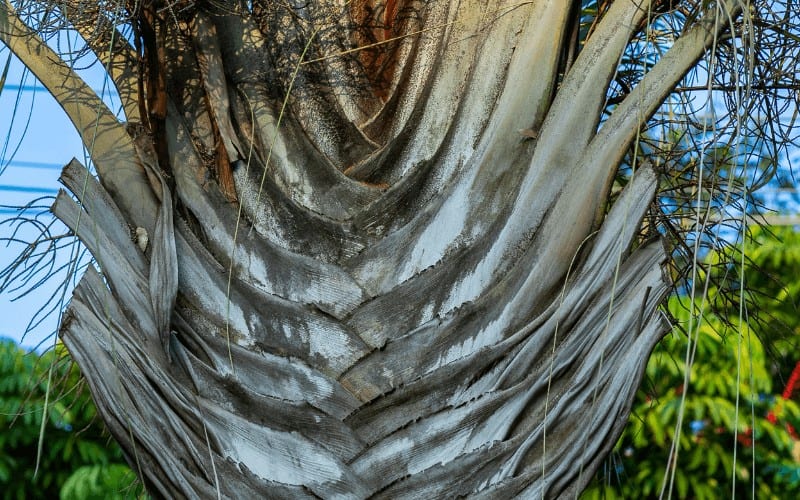
Triangle palm tree is a beautiful ornamental plant that is native to southern Madagascar. Triangle palm is most valuable as an accent plant or specimen tree when grown outside to display its astonishing shape. The palm tree blooms all year in suitable climates.
Dypsis decaryi prefers regular watering and full sun to thrive, even though it is not vulnerable to partial shade and occasional dryness.
Plant the palm in a well-drained sandy soil. It reaches up to 30 ft tall and 15 ft wide when fully matured. The blue-green fronds can also grow up to 10 ft long – and it’s hardy to USDA Zones 10 to 11.
2. Pygmy Date Palm (Phoenix Roebelenii)
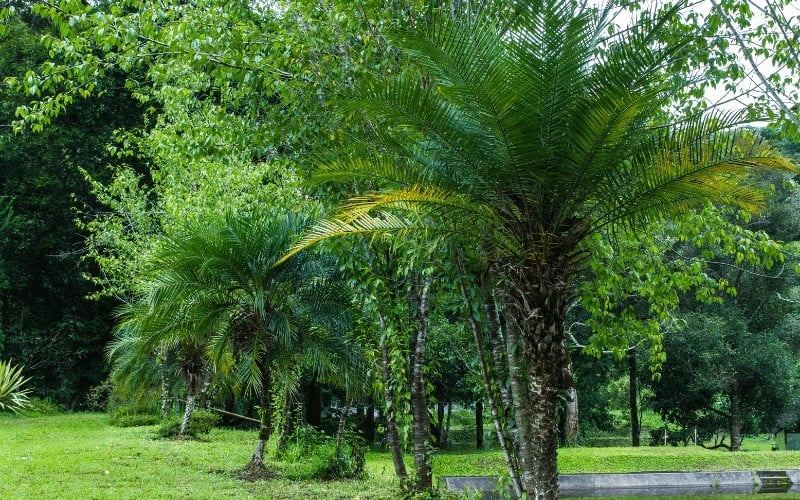
Originated from Southeast Asia, the pygmy date palm tree grows up to of 4ft tall when grown indoors and over 10ft tall when planted outdoors.
It has narrow leaves with pineapple-like, chunky trunk. It’s one of the feather types of palm plant grows in a very slow rate. The pygmy date palm hates repotting because it’s sensitive to its roots being disturbed.
This palm tree species serves as a fantastic ornamental flowering tree for subtropical landscaped gardens. The Phoenix Roebelenii have large and ostentatious arching-drooping fronds, which almost conceal the spiky-looking trunk.
These short palm trees also make for a good container plant – and is hardy to zones 10 and 11, according to Urban Forest Ecosystems Institute.
3. Pindo palm (Butia Capitata, jelly palm)
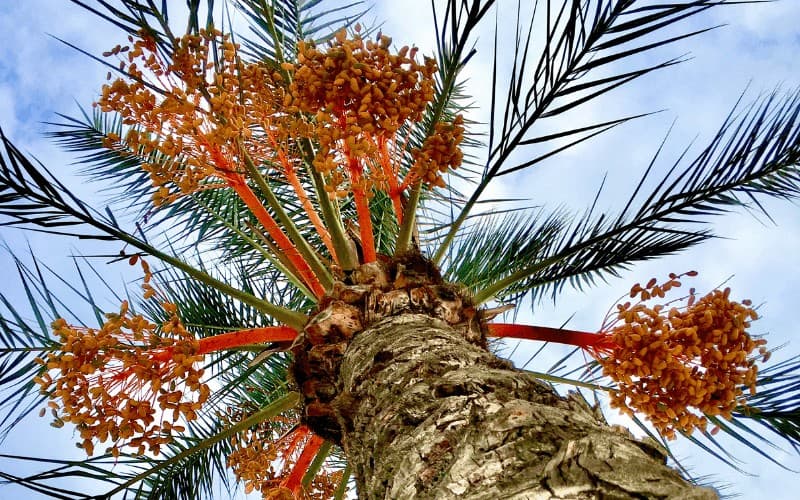
Also known as jelly palm tree, the pindo palm is seen as the hardiest palm tree in the feather palm category.
This palm originated from the grasslands of southern Brazil into Uruguay, Argentina, and Paraguay. It has a very unique appearance because of its highly recurved, blue-grey fronds.
Pindo palms can grow up to 20ft tall and can withstand temperatures of up to 5degrees – and is hardy in Zones 7b-11.
4. Chinese Fan Palm (Livistona Chinensis)
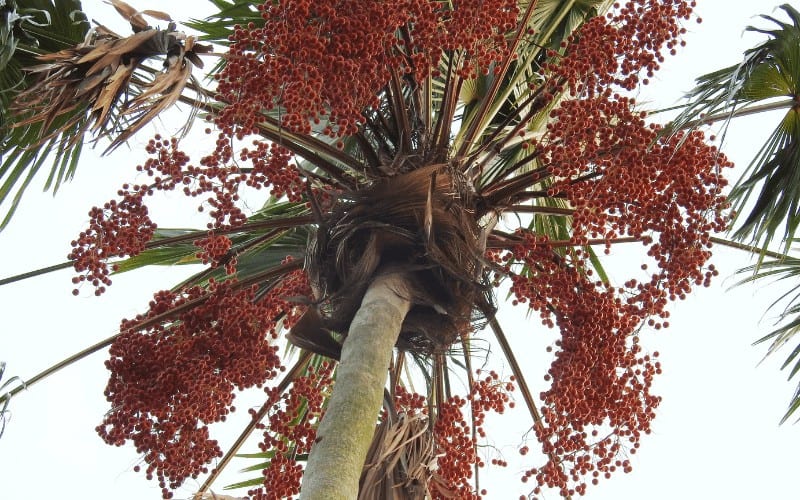
Also known as “fountain palm” and is native to Japan and China, the Chinese fam palm tree is a slow-growing tree. It got its name from its easily recognizable deep-green, fan-shaped fronds that looks like an open fan.
Chinese fan palm is tolerant of drought and somewhat tolerant of salt spray – and is adaptable to a wide variety of soils. They thrive well in full sunlight or in light shade.
Most growers love this tree because it’s seen as a survivor, growing well in different climatic conditions, soil, and light as I mentioned earlier. It is also frost and drought tolerant and they’re hardy in zones 9A–11.
5. European fan palm (Chamaerops)
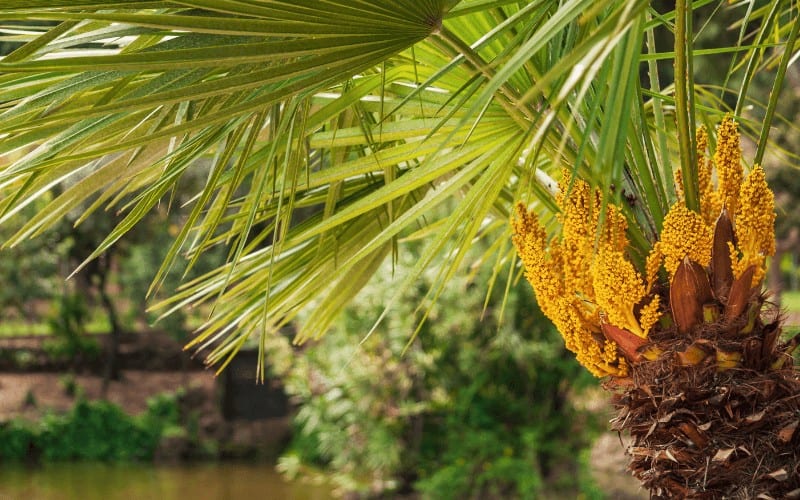
Also known as “Mediterranean Pan palm tree,” this is another small-growing, flowering palm species. The European fan palm has a few clustered trunks that gives the palm a more shrub-like appearance.
This small palm species reaches up to 10 ft – 20 ft. (2 – 5 m) tall when cultivated in warm climates. It has light green to silver-green palm fronds that grow in a fan shape. The leaflets are anywhere from 20 to and 30 inches (50 – 80 cm) wide, with each leaf growing up to 5 ft. (1.5 m) long.
The European fan palm is highly loved for its cold hardiness and ornamental value. Although it grows well in hot sun, it can tolerate temperatures as low as 10 °F (−12 °C). The Mediterranean Pan palm tree is hardy in Zones 7b-11.
6. Mazari Palm (Nannorrhops ritchiana)
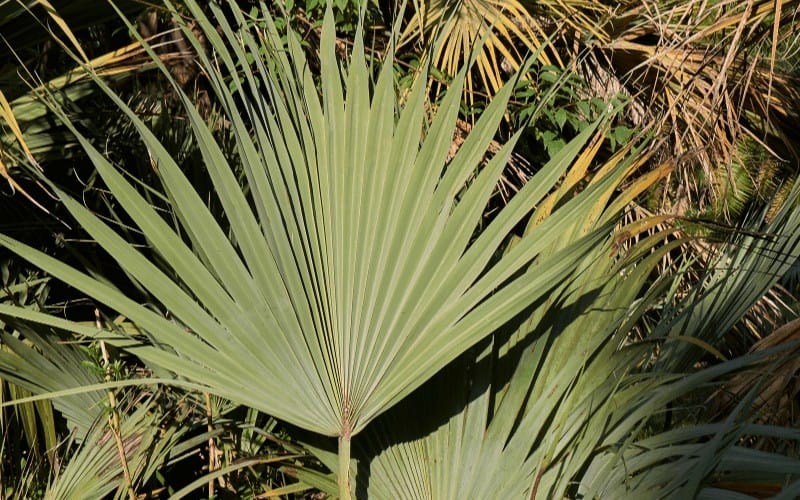
Native to southwestern Asia, the Mazari palm is more of a shrubby bush than a palm tree. It has palmate (fan-shaped) fronds that grow on clusters of stems. The leaves can grow between 1 and 4 feet. (30 – 120 cm) long.
The leaves have a striking appearance with very beautiful colors. The fronds are silver-blue or silvery-green in color, and it also has a long tapering leaflets, which give the palm a spiky look.
Like most other types of cold-hardy palm trees, the Nannorrhops ritchiana grows better in hot summers. However, this species of palm tree is equally cold-hardy down to 10 °F (−12 °C).
7. Cane Palm (Chrysalidocarpus lutescens)
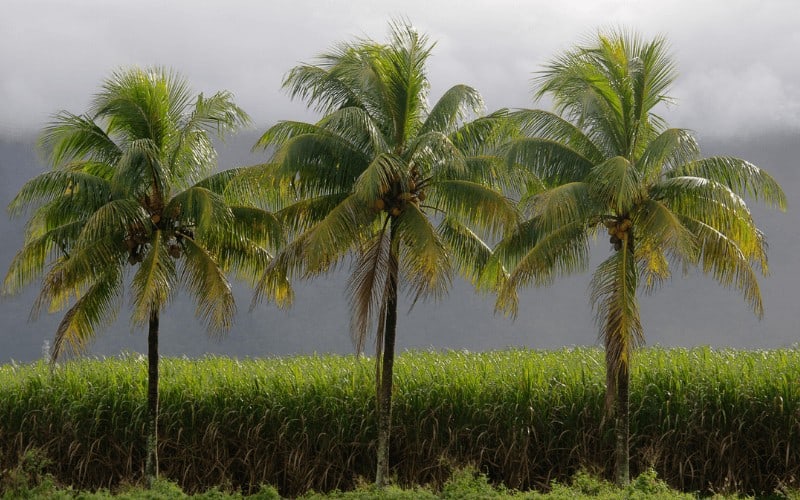
The cane palm is another type of palm tree that is commonly grown in buckets as a house plant, where it may not grow a trunk but makes a stunning upright clump of leaves.
The palm can also be grown as an outdoor plant in frost-free zones, where it will develop several trunks that looks more like thick canes of bamboo.
The cane palm is drought tolerant; however, it needs good drainage to thrive. This can be supplied by simply potting it up in a lightweight planting mix.
8. MacArthur Cluster Palm (Ptychosperma macarthuri)
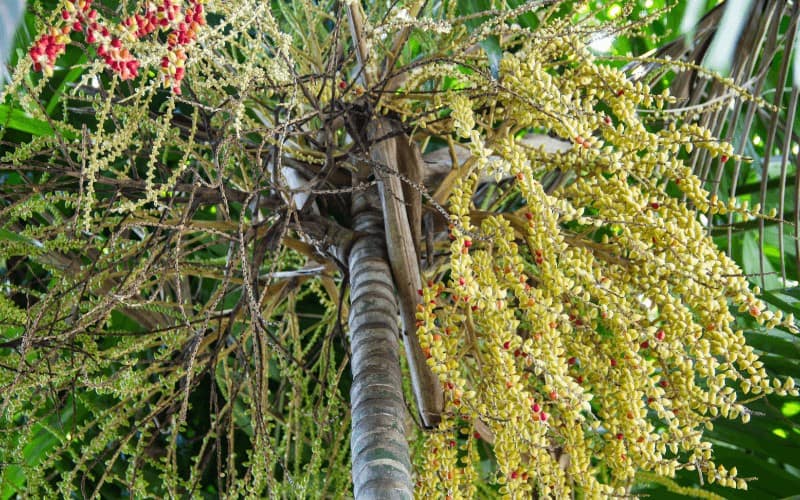
The MacArthur cluster palm is a type of small palm tree that bears large drooping flower clusters that hang multiple feet below the canopy when it matures, making it quite an impressive specimen.
The flowers produce colorful fruits and the palm tree continues with its fruiting and flowering cycle all year-round for a consistent display of attractive color.
The MacArthur cluster palm are small, topping out at about 15 ft, and survives better in full shade, full fun or anything in between.
It is a vigorous, drought tolerant species that can thrive in nearly any soil type and is often planted in groves.
9. Bottle Palm (Hyophorbe lagenicaulis)

Bottle palm trees are native to Round Island, Mauritius. You can easily identify them by their swollen stems which taper toward the canopy like an old-fashioned soda bottle.
They are a slow growing, heat-loving species and grows up to 20 ft tall. It can live its entire life in a large planter, provided they are kept in a sunny location. The bottle man is hardy to USDA zones 10 to 11.
10. Silver Fan Palm Tree (Coccothrinax argentata)
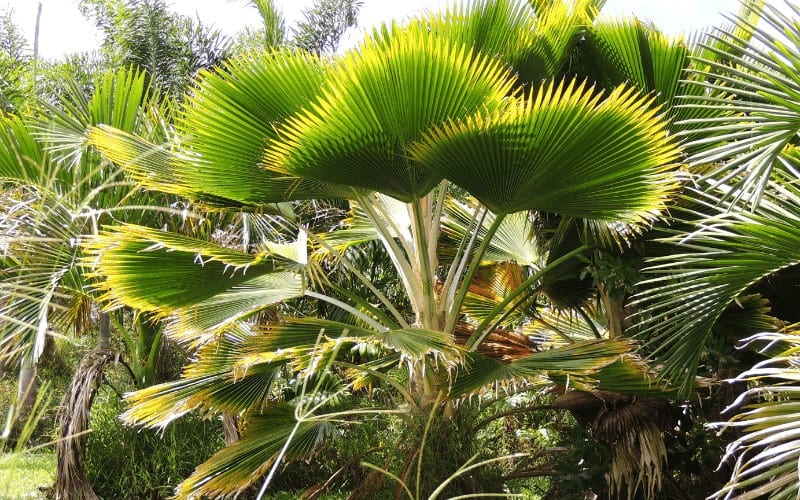
Native to western and northern Madagascar, the silver fan palm tree grows as a multi-trunked specimen and forms clumps up to 20 ft tall with a width of about 10 ft.
The trunks have an arched shape and the foliage has a silver green, fan-shaped frond. This tree can tolerate drought, extreme heat, poor soil, and high winds.
It also happens to be one of the most cold-tolerant species of palm trees and is hardy to USDA zones 8b-11.
11. Sago Palm Tree (Cycas revoluta)
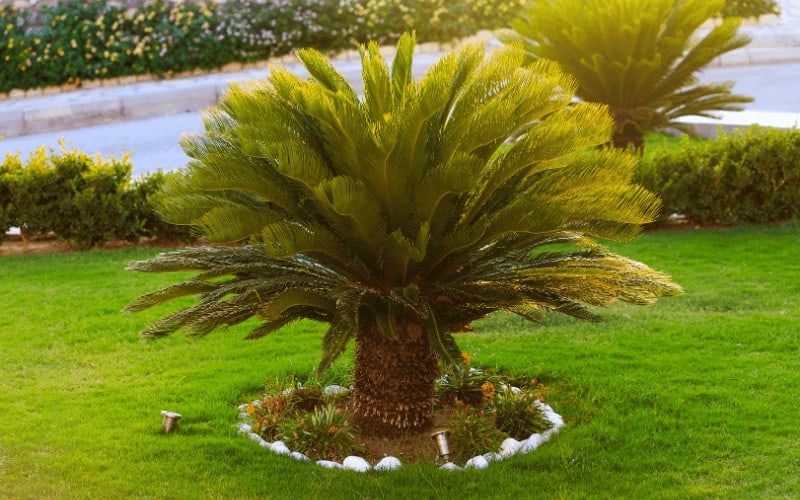
Native to Japan, the Sago palm is a member of the Cycadaceae family, which may take a palm appearance, but is botanically different. This palm tree can be easily identified by its fern-like new leaves and short trunk.
Although the Cycas revoluta is known as the Sago palm, it is not entire a palm tree. It can thrive in sandy, fast-draining soil as heavy, moist soil leads to prolonged health issues in the roots.
The Sago palm is suitable in USDA zones 9 to 11.
12. Dwarf palmetto (Sabal minor)
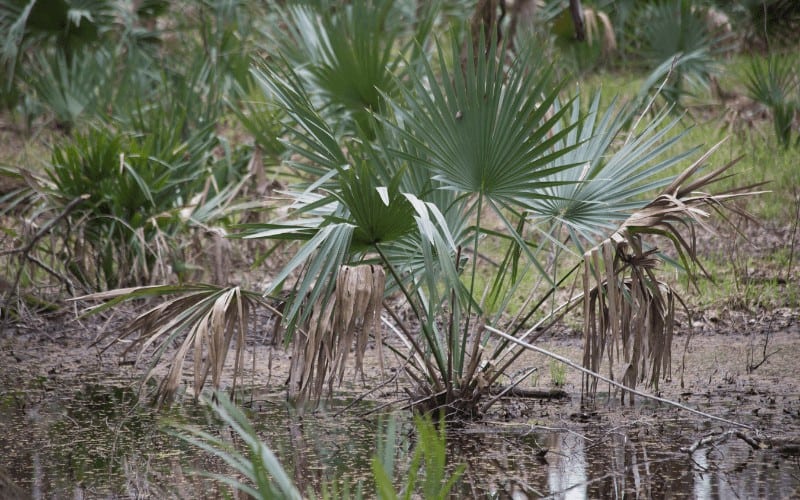
It is an evergreen palm tree that belongs to the Arecaceae family and is native to North America. The dwarf palmetto palm tree is also one of the hardiest species of palm out there.
It is called scrub or bush palmetto and it grows with a small (or no) trunk at all – and has over 40 leaves in one spine.
The fronds are narrow and pointed which generally appears like a fan. It is salt and drought tolerant and is hardy in hardy to 10°F (-12°C).
Types of Tall Palm Trees (Other Types of Palm Plants)
Depending on the type of garden you have and your climate, there are several species of tall palm trees out there that look incredibly attractive in subtropical and tropical gardens.
Below are other types of palm trees available today:
13. Date Palm Trees (Phoenix spp.)

True date palm trees have been grown since ancient times in the Middle East, the Mediterranean, and North Africa for their sweet, edible fruits.
The date palms are also cultivated in some parts of the United States for commercial use, including California, Nevada, and Arizona. Some cultivars can thrive in secluded spots up to zone 8, and still yield fruit for years.
Date palms or Phoenix palms are also related to the true Date Palm; however, they do not grow comparable fruit. Phoenix palms are usually either male or female – and they all grow in arid locations and develop similar feathery foliage.
Some date palm species grow quite large, while others stay small. For example, the Pygmy date palm (P. roebelenii) is an excellent choice for houseplant lovers who can offer the plant enough natural sunlight. It can also be grown as a landscape tree in Zones 9 to 11.
14. Silver Thatch Palm (Coccothrinax proctorii)
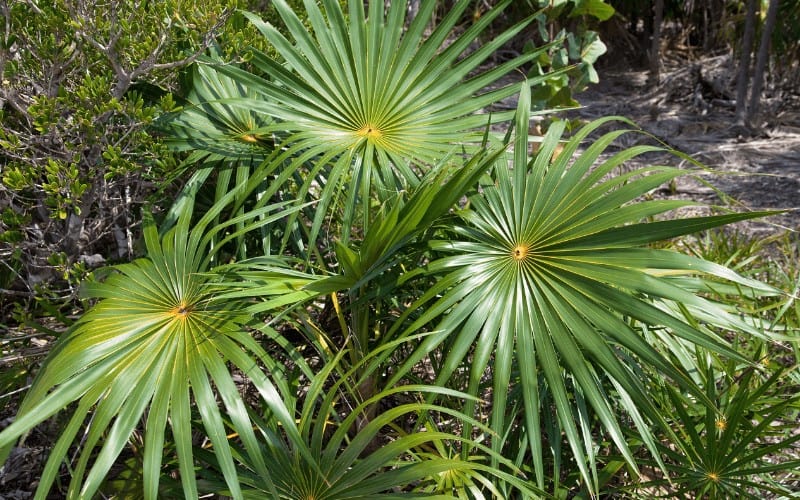
The silver thatch palm is a medium sized, slow growing palm tree is native to the Cayman Islands. It has a slender trunk with an open crown of deeply divided fronds.
The palm grows well in a sunny, moist, but well-drained area. It is tolerant to salt, prefers alkaline soil – and can be cultivated on just coral limerock. Its silver-green fan-shaped fronds is traditionally used as a thatching material.
Finally, this palm grows upright with a single trunk up to about 20 ft tall and has a small, tight crown – and is hardy in USDA Zone 10a: to -1.1 °C (30 °F).
15. Caranday palm (Copernicia alba)
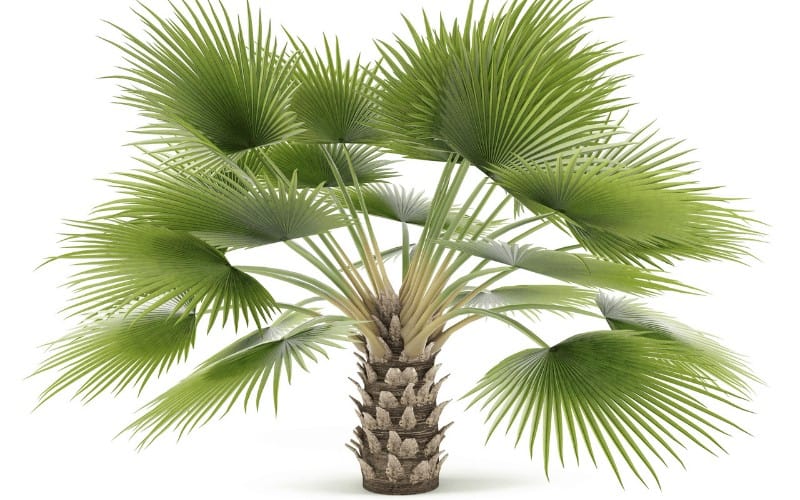
The caranday palm is another slow growing palm tree that is native to South America. It has an incredibly hard trunk that has been used for telephone poles and fences over the years.
Also known as wax palm, caranday palm leaves produce a wax that is used for making lipstick, candles, and car wax.
The palm plant grows up to 70 ft tall in the wild – and it usually form large, single species woodlands in its native range.
But it grows up to 30 ft tall and 15 ft wide in the landscape. Caranday palm develops a solitary trunk with fan-shaped fronds that reaches about 2 ft wide. It is also a cold hardy palm tree and is suitable for landscapes in USDA zones 9-11.
16. Foxtail Palm (Wodyetia bifurcata)
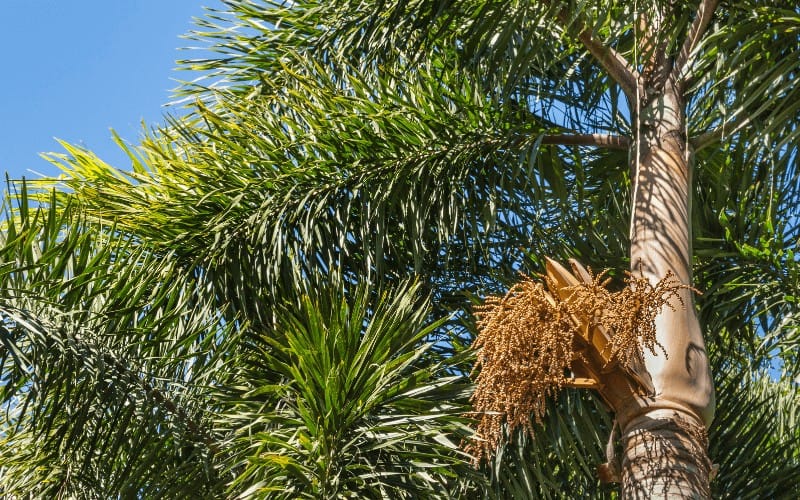
Foxtail palm is native to Australia and it’s a popular landscape species that is often grown for its self-cleaning habit, attractive plume-like leaves, and compact, symmetrical form.
Wodyetia bifurcata grows on a solitary smooth gray trunk and gets up to 30 ft tall and about 15 ft wide. When flower pollination is over, foxtail palm grows large orange fruits, which increases its ornamental value.
Foxtail palms is a fast growing plant and thrive well when cultivated in soil with a liberal amount of organic material added to the hole with constant fertilization. The palms prefer consistent moisture but can tolerate moderate drought as they begin to mature.
Interesting, old foliage often falls off Foxtail palm trees, unlike other palm trees that require constant pruning of old, brown fronds to maintain a clean appearance. The foxtail palm tree is hardy to USDA Zones 10 to 11.
17. Florida Thatch Palm (Thrinax radiata)
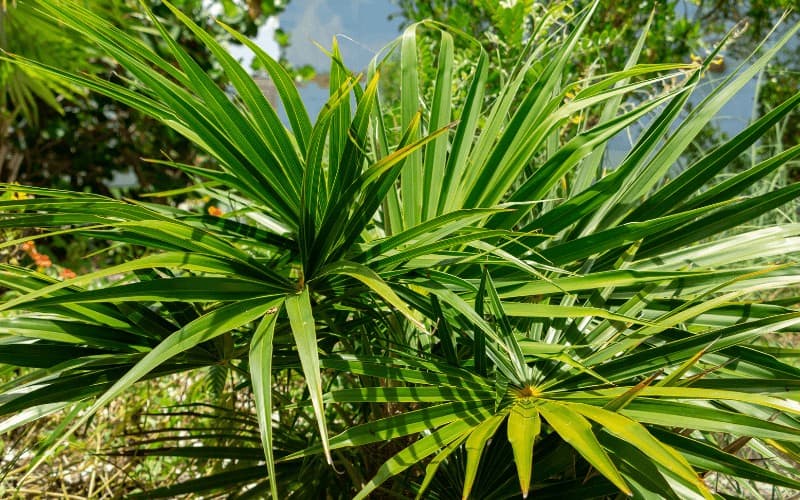
Native to South Florida and many Caribbean islands, the Florida thatch palm tree is a slow-growing palm with fan-shaped leaves that grows up to 20 ft tall and 10 ft wide when fully matured. It’s drought tolerant and prefers well-draining sandy soils to thrive.
The palm’s slow growth rate and small size make it a great choice for small spaces. Its slow growing rate and bushy habit while young also makes it suitable as a screening plant.
The Florida thatch plant also serves wildlife as a source of food and nesting site for birds and a host plant for the monk skipper butterfly, enhancing the native wildlife habitat. This palm plant is hardy to USDA Zones 10 to 11.
18. Spindle Palm (Hyophorbe verschaffeltii)
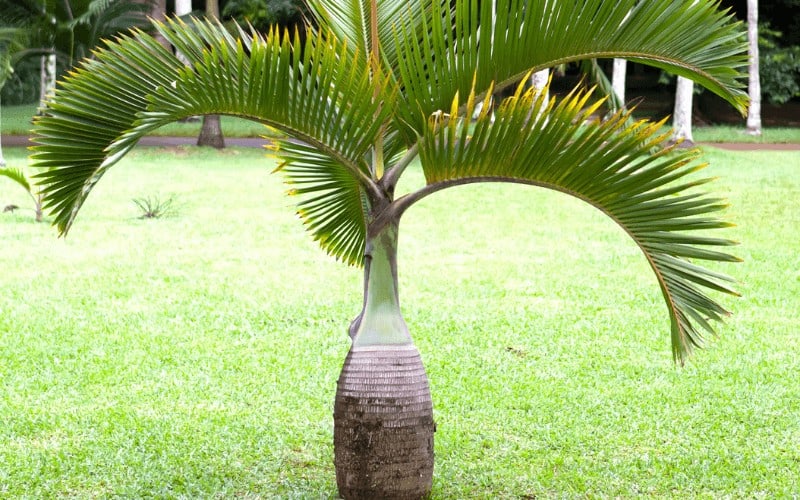
Spindle palm is native to the Mascarene Islands of the Indian Ocean, where it naturally grows in sandy soil that drains well. It has a slow growth rate and reaches up to 20 or 25 ft tall in the landscape, with about 6- to 10-foot leaves.
It has a solitary gray, ringed trunk that is thickest at the midpoint with white or cream-colored flowers and fruits that ripens from orange to red.
The spindle palm can also make a great landscape focal point, with/without having to underplant accent flowers and foliage.
It comes as houseplants and thrives best indoors when given enough sunlight and good air circulation. It’s hardy to USDA Zones 9b to 11.
19. Mexican Palm tree (Washingtonia robusta)
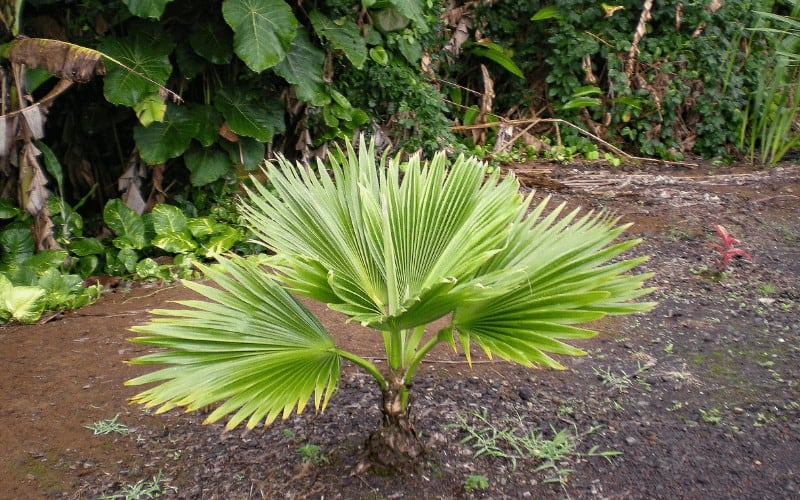
The Mexican palm tree has a long narrow trunk with bushy-like leafy foliage mounted at the top. It also has palmate fanned leaves which measures about 3.3 feet (1 m) long and is gracefully sited on top of 82 feet. tall (25-m tall) stems.
Washingtonia robusta grows clusters of edible fruit (dates), although they are not as sweet as dates produced by other types of palms.
They can grow up to 80 to 100 ft. (24-30 m.) tall – and they produce dark green and fan shaped leaves, reaching about 3 to 5 ft. (1-1.5 m.) tall. Mexican palm is hardy in USDA zones 9 to 11 and Sunset zones 8 to 24.
20. Canary Island Date Palm (Phoenix canariensis)
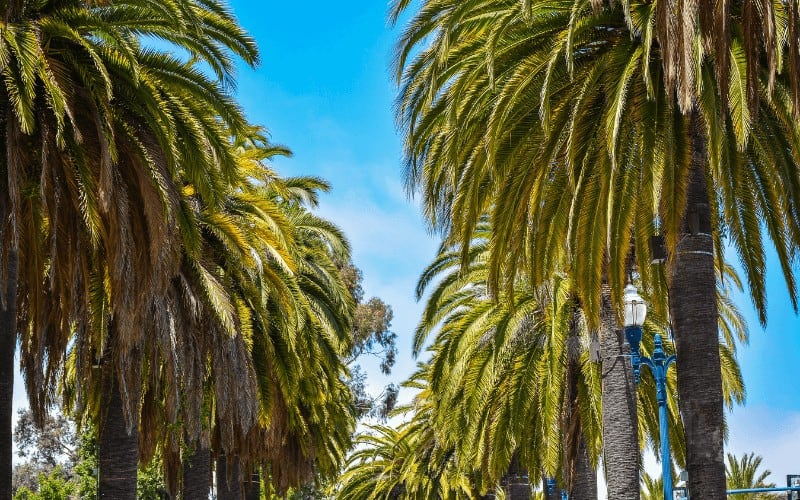
The Canary Island date palm tree is very popular palm tree that is often planted in the home landscape. It’s a very beautiful tree that is native to the warm Canary Islands.
It’s a dramatic palm species that is typically seen with a short trunk and large crown of leaves that looks like a pom-pom.
It easily adapts to soil type and watering regimes; however, it still requires the laborious yearly maintenance of pruning off the huge fronds as they die off. The Canary Island date palm is hardy to zones 9 to 11.
21. Chilean Wine Palm (Jubaea chilensis)
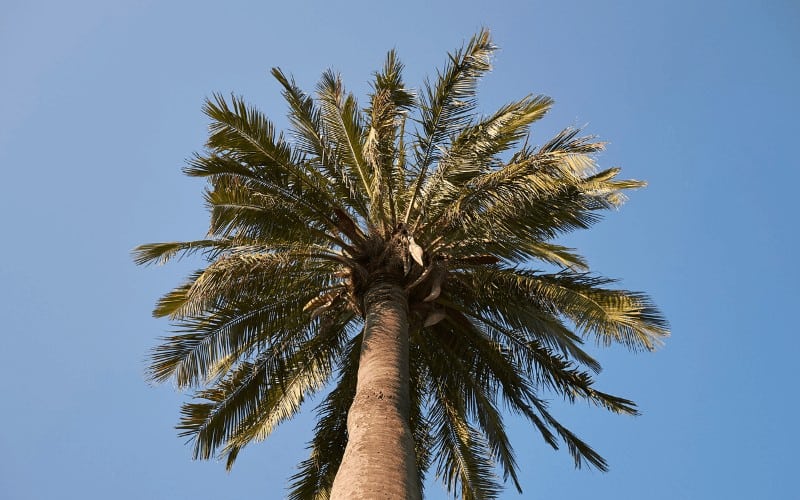
Native to South America (Chile), the Chilean wine palm is the largest palm tree in the world, growing up to 100 ft. tall with a trunk of about 5 ft. in diameter. However, this massive tree has a very slow growth rate, taking hundreds of years to get to this size.
They are cut for their sap in their native Chile, and is usually turned into a product that looks like maple syrup.
The Chilean wine palm is very tolerant to drought and thrives well in dry, well-drained soil. The palm is hardy to USDA 7-10.
Important FAQs About Palm Trees
Having shown you some of the most popular types of palm trees in the world, we thought it will also make some sense to also address some of the most frequently asked questions about palm trees.
What is the tallest palm tree in the world?
The wax palms are the tallest palm tree type in the world. It can grow to up to 200 ft. tall. It is also the tallest recorded species of monocot.
What is the most expensive palm tree?
Coco de Mer Palm Tree is considered the most expensive palm tree in the world. It grows up to 82-110 ft. tall and must grow for 20-40 years before flowering.
How much does a 30 foot palm tree cost?
A 30 ft tall or shorter palm tree usually cost from $75 to $400, while the ones that are 60 ft or more goes for $200 and $1,200.
How much is a royal palm tree cost?
The royal palm tree cost between $200 and $250 each.
Should palm trees be skinned?
Yes, palm tree should be skinned, but that should be done only if the tree is flowering and bearing fruits, if the fronds constitute a hazard to people or property, or if the fronds are broken or dead.
It’s a good practice to always look out for dying or dead fronds on the palm and cut them off.
What is the fruit of the palm tree called?
Different palm trees produce different fruits, such as coconuts, dates, betel nuts, and acai fruit.
How old do palm trees live?
7 to 8 decades is average lifespan of a palm tree. However, it’s worth mentioning that some palms only live for 40 years, while others can live up to 100 years.
What is the smallest outdoor palm tree?
The smallest outdoor palm tree is dwarf palmetto, which may only grow up to 3 ft (1 m) tall.
What is the best looking palm tree?
Kentia Palm is arguably the best looking palm tree species. Kentia Palm are adaptable to a wide variety of soil conditions.
They’re also pretty much easy care for as they require little pruning and are one of the cleanest palm trees.
What is the largest palm tree?
The world’s largest palm tree is the Quindío wax palm. It can grow up to 60 meters tall and can be found in montane forests of the Andes. It is a “diecious species” (trees that are either male or female). They can be easily identified by their flowers.
Do palm trees have deep roots?
Palm trees do not grow long, deep taproots like some trees such as oak tree for example. Generally, they grow in the top 36 inches of topsoil where there’s plenty of water and nutrients.
Do palm trees need lots of water?
Yes, palm trees need enough water to survive as they like moist soil. You’re required to water your palm plant several times.
Typically, you'll want to water palm trees daily for the first week of its planting. Water every other day the second week. And after that, water two or three times per week.
Can palm trees take full sun?
Most palm trees prefer shade to grow and may hardly survive if they’re exposed to too much direct sunlight. And for low-light palm species, they thrive best in bright indirect sunlight but can also endure less sunlight, especially during the winter period.
What is the easiest palm tree to grow?
Areca palm is believed to be one of the easiest-to-grow palms. They tolerate bright, indirect sunlight to part shade.
Related Posts:
- How To Revive a Dying Palm Tree
- How to Trim Palm Tree Trunk [7 Pro Steps]
- What Is Growing Out Of My Palm Tree?
- How To Stop A Palm Tree From Growing Taller
- How To Deal With White Fungus On Palm Trees
Conclusion | Types of Palm Plant
As you can see, there are several types of palm trees out there. Whether you live in a colder climate or in the subtropical areas of the country, you will always find a palm tree that’ll perfectly fit your landscaping needs.
All you need to do right now is to pick one that’s suitable for your needs, learn everything you should about it and go with it.




